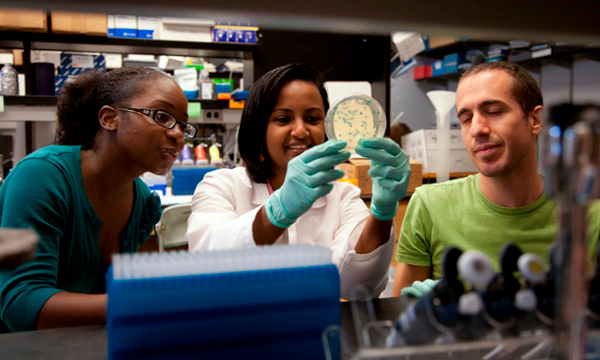Academic Overview

The graduate program in Neuroscience at Emory University is an interdisciplinary program, spanning many departments and priding itself on a collaborative atmosphere encouraging excellence. Our faculty and students have a broad scope of research interests within neuroscience, ranging from molecular to cellular to behavioral neuroscience.
Our program is one of eight PhD programs that comprise the Emory Graduate Division of Biological and Biomedical Sciences (GDBBS). There are over 330 faculty members in the Division, and graduate students of any program in the Division face no departmental barriers. They can do laboratory rotations and research with any of the Division Faculty. They can also switch to one of the other programs, have an advisor from another program and take any course offered by the Division. This structure gives students tremendous flexibility in choosing coursework, advisors and research plans. There are about 80-100 total students enrolled in the program from year to year and the average time to finish the degree is about 6 years. Our alumni go on to successful careers in industry, academia, law and government.
Admission
On-line applications and further information can be found at the GDBBS admissions website. Several criteria are considered in the initial evaluation. The most important variable is research experience. Demonstrated success (GPA) in a variety of undergraduate courses in the physical and natural sciences that provide the necessary foundation for graduate study of the chemical, physical, and biological properties of the nervous system is expected. Letters of recommendation (especially from a research mentor) and the statement of goals are also important. Promising applicants are invited for an interview. Historically, the Neuroscience Graduate Program receives ~350 applications per year for 16 places in the program.
Students admitted to the program typically have a strong background in the natural sciences, although no particular degree is required. Current students have undergraduate degrees ranging from life/physical sciences (biology, biochemistry, chemistry, physics, psychology) to engineering, and mathematics. Women and minorities are encouraged to apply, as are men and non-minorities.
Joint Degree Programs
MD/PhDApproximately 10-15% of Neuroscience graduate students are working towards an MD degree or already have one. MD/PhD students are admitted through the MD/PhD Program.
Financial Aid
All students receive a full tuition scholarship, complete health insurance coverage, and an annual stipend. Students are guaranteed 5 years of stipend support. The faculty encourages and assists students in obtaining individual stipend support from extramural sources such as federal agencies and private foundations. Students with such support receive an annual added bonus of $2,000. See the Financial Information page for more details.
Coursework
The program curriculum consists of 1 year of required neuroscience courses, 1 elective, a research statistics course, 3 research rotations, graduate seminar courses, attendance at the Frontiers in Neuroscience seminar series for the first two years, and the student's individual thesis research.
Rotations
Students typically perform three research rotations in different labs before choosing a thesis project and advisor. Rotations are designed to introduce students to an array of labs, techniques, and approaches to neuroscience.
Teaching
The program offers several opportunities for students to gain teaching experience. After their first year, students are required to participate in a weeklong summer training workshop. Faculty for this course are drawn from among the best teachers across the university. There are workshops on syllabus writing and grading, lecturing and leading discussions, the use of writing as a pedagogical tool, the conduct of lab sessions, and the use of new technologies. This workshop is designed to prepare students to be teaching assistants (TA) for one class during the second year. Students can choose to TA more classes in subsequent semesters if desired, but only one assistantship is required.
In addition, all students must participate in weekly seminars for the first 2 years of the program. These seminars are informal venues where students present either relevant papers or their own research to their peers and a small group of faculty members. From this experience, students learn presentation and communication skills essential to a career in science.








